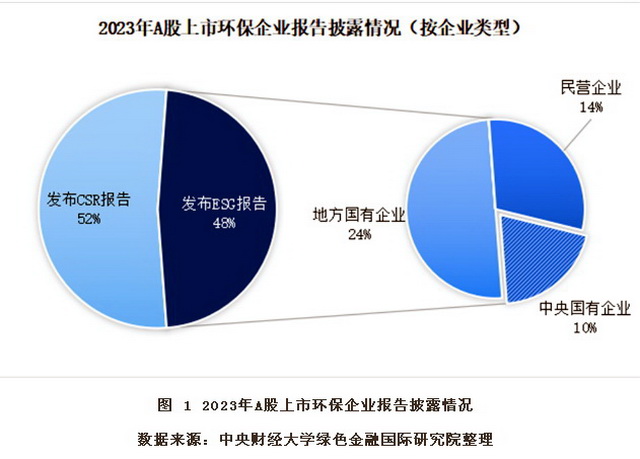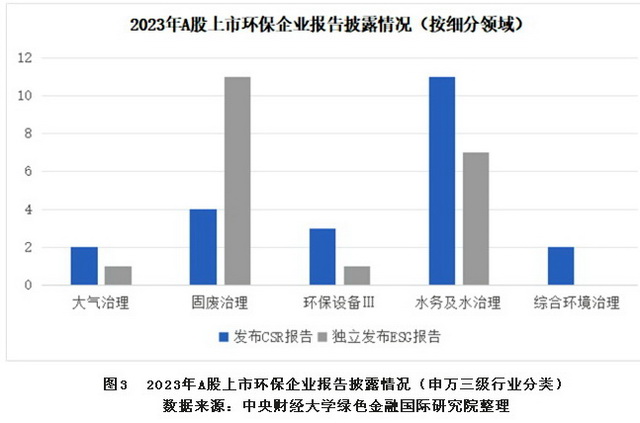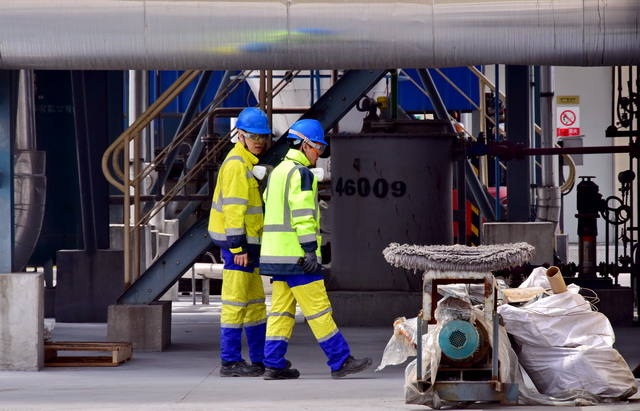The three-level regulations of "mandatory, guided and encouraged" have improved the level of corporate environmental information disclosure
According to the latest survey results released by a number of institutions, as the concept of environmental, social and governance (ESG) has gradually become a consensus, the level of environmental information disclosure of Chinese enterprises has steadily improved, but there is still a lot of room for improvement.
According to the results of the 2023 survey on the ESG development and current situation of environmental protection enterprises released by the International Institute of Green Finance of the Central University of Finance and Economics, 42 companies with the "environmental protection" label of Shenwan's first-level classification are found to be the core sample, and 42 companies have fully disclosed non-financial related information in 2022. Among them, 48% of enterprises independently publish ESG special reports, and two-thirds of them are central state-owned enterprises and local state-owned enterprises.
The survey found that the proportion of ESG reports disclosed by different enterprises from high to low was central enterprises (80%), local state-owned enterprises (50%), private enterprises (37.5%), and public enterprises (0%), which is consistent with the top-down promotion of China's policies. It can be seen that the ESG-related system requirements of the SASAC have effectively promoted the information disclosure of state-owned enterprises, and private enterprises need to enhance ESG awareness and strengthen ESG information disclosure. Rong Jun, an ESG assistant researcher at the International Institute of Green Finance at the Central University of Finance and Economics, said.
As an important support for China's green transformation and development, the environmental protection industry mainly includes air treatment, water affairs and water treatment, solid waste treatment, environmental protection equipment, comprehensive environmental governance and other fields.
China's environmental protection industry has different levels of type division in multiple dimensions such as the number of enterprises, operating income, operating profit and number of employees. Among them, the production of environmental protection products is dominated by air pollution prevention and control equipment and water pollution prevention and control equipment, followed by solid waste treatment and disposal equipment, environmental monitoring and testing equipment.

2023 A-share listed environmental protection enterprise report disclosure. Source: International Institute of Green Finance, Central University of Finance and Economics
According to Rong Jun, according to the Shenwan industry classification, the 42 sample environmental protection enterprises are all large and medium-sized enterprises, and in the subdivisions, the number of water affairs and water treatment accounts for the highest proportion (43%), followed by solid waste treatment enterprises (36%). Although the number of water and water treatment companies is higher than the number of solid waste treatment companies, the latter has a higher proportion of ESG reports (73.33%).
Among the 42 enterprises, the number of central state-owned enterprises and local state-owned enterprises accounted for more than half, which is related to the reform of state-owned enterprises and central enterprises in recent years. In the process of entering the environmental protection industry by state-owned enterprises and central enterprises in the form of mixed ownership reforms such as investment and equity participation, mergers and acquisitions, etc., the level of governance has been further improved.
Chongqing Water Group Co., Ltd. adheres to the principle of "reduction, reuse and recycling" and implements the recycling model of "production-waste-renewable resources-production", which not only enables the enterprise to successfully transform from extensive development to ecological development, but also promotes the overall development of circular economy.
Yuanda Environmental Protection Co., Ltd. promotes resource recycling through technological transformation and other means, promotes energy conservation and consumption reduction, changes the original gas boiler steam heating to electric energy instead of heating, reduces natural gas consumption by 630,000 cubic meters and reduces carbon dioxide emissions by about 1,400 tons per year, optimizes the development of recyclable mixture packaging ton bags through packaging bags, and develops a comprehensive utilization technology for waste catalyst resources for waste catalysts.
The study finds that due to the natural attributes of the environmental protection industry and the strong penetration of the industrial chain, relevant enterprises can provide environmental protection equipment and energy-saving and emission reduction technologies for polluting enterprises, and further promote the green transformation of energy, chemical and other industries, so as to provide technical support for the transformation and upgrading of the industrial structure and help the country achieve the "double carbon" goal.
"The construction of ESG system by enterprises is conducive to standardized management, transformation and upgrading, and risk prevention, and helps enterprises develop sustainably and with high quality. Although the overall rating of environmental protection enterprises is high, most of them have not yet established a sound ESG system, lack ESG development strategies, and the quality of ESG report disclosure is not high, so there is still a lot of room for improvement. Yang Chenhui, co-director of the ESG Center of the International Institute of Green Finance of the Central University of Finance and Economics, said.

2023 A-share listed environmental protection enterprise report disclosure (Shenwan three-level industry classification). Source: International Institute of Green Finance, Central University of Finance and Economics
Shi Yichen, chief economist of Zhongcai Green Index (Beijing) Information Consulting Co., Ltd., also said that environmental protection enterprises, as an important force in the construction of ecological civilization and pollution prevention and control, must strengthen their own sustainable development capabilities, match the increasingly stringent ecological and environmental protection supervision needs with higher-quality industrial development momentum, and support the low-carbon and green transformation of the economy.
Previously, the "Evaluation Report on Environmental Responsibility Information Disclosure of China's Listed Companies (2022)" jointly released by the China Environmental Journalists Association and Beijing University of Chemical Technology in Beijing also introduced that among the 5,078 listed companies in the Shanghai and Shenzhen stock markets, the total number of enterprises that issued effective samples such as social responsibility reports, ESG reports, sustainable development reports, environmental reports and corporate citizenship reports in 2022 reached 1,675, accounting for 32.99% of the number of all listed companies , an increase of 387 over the previous year, an increase of 25.42%.
"The number of companies publishing relevant reports has increased year by year, and the level of disclosure has steadily improved, reflecting the deepening of enterprises' understanding of national policies and the continuous improvement of their awareness of environmental information disclosure. Bai Zhijun, secretary general of the China Environmental Journalists Association, said.
Bai Zhijun also said that although the overall level of disclosure has been steadily improved, there are still some enterprises that do not have a strong sense of disclosure. Combined with the information reported by the Ministry of Ecology and Environment in 2022, some listed companies have not disclosed them on their official websites or relevant reports after being notified or punished for ecological and environmental protection issues.

Photography / Zhang Ke
In recent years, the China Securities Regulatory Commission, the State-owned Assets Supervision and Administration Commission, the Hong Kong Stock Exchange, the Shanghai Stock Exchange, the Shenzhen Stock Exchange and other institutions have shifted their information disclosure requirements from corporate social responsibility reports to ESG reports, and gradually showed a trend of mandatory disclosure. At the same time, the policy encourages enterprises to carry out special work such as biodiversity conservation and climate information and related information disclosure.
Earlier this month, the Shanghai Stock Exchange (SSE) issued the Self-Regulatory Guidelines for Listed Companies on the Shanghai Stock Exchange No. 14 – Sustainability Report (Trial) (Consultation Paper) (the "Guidelines") and solicited public comments from the market.
The Guidelines clarify environmental, social and corporate governance disclosure issues. The chapter on environmental information disclosure sets up important topics such as climate change, ecosystem and biodiversity conservation, circular economy, and energy use. The chapter on social information disclosure sets up important topics such as rural revitalization, innovation-driven, science and technology ethics, supply chain security, and equal treatment of small and medium-sized enterprises. The chapter on corporate governance information disclosure is dedicated to topics such as anti-corruption, anti-bribery, and anti-unfair competition.
The Guidelines stipulate that companies that continue to be included in the sample of the SSE 180 and STAR 50 Indexes, as well as companies listed at home and abroad during the reporting period, shall disclose the Sustainability Report, and encourage other listed companies to do so on a voluntary basis. In terms of disclosure topics, differentiated disclosure requirements are set for different topics according to the levels of mandatory disclosure, guided disclosure and encouraged disclosure.
A number of experts suggested that third-party institutions should be strengthened to participate in supervision and evaluation, continue to improve the quality of corporate environmental information disclosure, listed companies should strengthen external exchanges and cooperation, enhance the brand image of environmental responsibility, and enterprises should integrate environmental responsibility into strategic planning to better support sustainable development.







